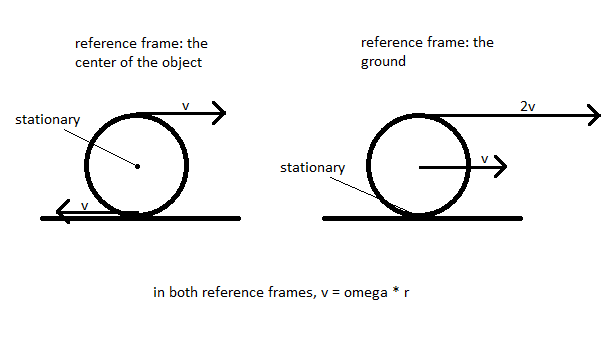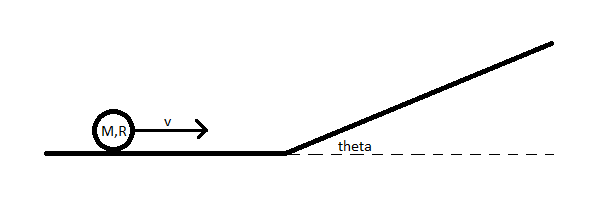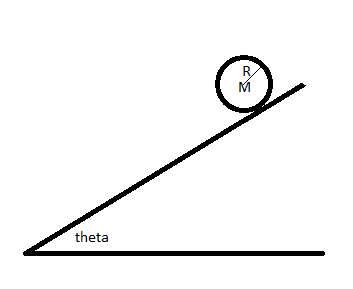Rolling Motion
The Main Idea
Rolling motion is the turning motion of a round object, such as a sphere or cylinder, along a surface against which it is pressed. Rolling objects both rotate about their central axes and move translationally, so they have both rotational and translational kinetic energy. The rotation of a rolling object is the result of Friction between its edge and the surface, which applies a Torque. When rolling happens without slipping, this friction is Static Friction because the edge of the rolling object does not move relative to the surface. The point of contact between the object and the surface constantly changes but does not slide. For an object rolling at a constant speed, the magnitude of this static friction force is 0. However, for an object accelerated by an external force, such as a disk rolling down a ramp, the static friction force has a nonzero magnitude to prevent the disk from slipping. Without this friction force, a disk placed on a ramp would simply slide down without rotating. Sometimes, slipping does occur. This can happen if, for example, the object is accelerated along the surface so quickly that the maximum static friction force cannot cause a sufficient corresponding angular acceleration, or if the object was already moving with an arbitrary Angular Velocity when it came into contact with the surface. In these situations, a Kinetic Friction force acts between the edge of the object and the surface. This kinetic friction force attempts to reduce the relative motion between the object's edge and the surface by adjusting the angular velocity of the object. Eventually, if no other forces act on the object or the surface, the angular velocity will be such that the object no longer slips.
Consider an accelerating object that rolls without slipping. Since the object is accelerating, there is a nonzero static friction force acting on its edge. Does this static friction force do work on the system? The answer depends on whether the rolling object is modeled as point particle system or a real system (see Point Particle Systems and Real Systems). If the system is treated as a point particle, the static friction force is treated as though it acts on the particle's center of mass. It is therefore exerted over a distance and does work, affecting the object's total kinetic energy. If the system is treated as a real object, the static friction force is recognized as acting on the object's stationary edge, and therefore does no work. For the real system, the object's total kinetic energy would be the same even if the static friction force at its edge were absent. The only difference is that now some of its kinetic energy is rotational rather than translational. Point particles cannot have rotational kinetic energy, so the static friction force is treated as though it does work to account for the difference in total kinetic energy.
Mathematical Model
Some equations regarding the geometry of rotating objects
For any rotating object,
- [math]\displaystyle{ v = \omega r }[/math]
where [math]\displaystyle{ v }[/math] is the translational speed of the edge of the object relative to its center, [math]\displaystyle{ \omega }[/math] is the angular speed of the object in radians per unit time, and [math]\displaystyle{ r }[/math] is the radius of the object.
For an object rolling at a constant speed without slipping, [math]\displaystyle{ v }[/math] is also the translational speed of the object. This is because the bottom edge of the object is always stationary with respect to the ground (or it would be slipping). However, this bottom edge has a speed of [math]\displaystyle{ v }[/math] with respect to the center of the object. This means that the center of the object has a speed of [math]\displaystyle{ v }[/math] with respect to the bottom edge and therefore the ground. The topmost edge of the object has a speed of [math]\displaystyle{ 2v }[/math].

One can also differentiate both sides of [math]\displaystyle{ v = \omega r }[/math] with respect to time to yield:
- [math]\displaystyle{ \frac{d}{dt}(v) = \frac{d}{dt}(\alpha r) }[/math]
- [math]\displaystyle{ \frac{dv}{dt} = \frac{d\omega}{dt} r }[/math]
- [math]\displaystyle{ a = \alpha r }[/math]
where [math]\displaystyle{ a }[/math] is the translational acceleration of the edge of the object relative to its center [math]\displaystyle{ \left(\frac{dv}{dt}\right) }[/math], [math]\displaystyle{ \alpha }[/math] is the angular speed of the object in radians per unit time squared [math]\displaystyle{ \left(\frac{d \omega}{dt}\right) }[/math], and [math]\displaystyle{ r }[/math] is the radius of the object.
Solving problems about rolling objects
The effects of kinetic friction on an object that slips while rolling are usually relatively easy to find because the [[Kinetic Friction] force acting on the object has a known, easy to calculate magnitude ([math]\displaystyle{ \mu_k * N }[/math]) and acts in a known direction (the direction opposing motion). The kinetic friction force causes a translational acceleration according to Newton's Second Law: the Momentum Principle as well as an angular acceleration according to The Angular Momentum Principle.
The effects of static friction on objects that accelerate by rolling without slipping can be harder to find because the magnitude of the friction force is often not explicitly given. Recall that the magnitude of a static friction force can be anywhere between 0 and a maximum value ([math]\displaystyle{ \mu_s * N }[/math]). For problems involving rolling objects, the magnitude of the static friction force usually does not reach its maximum value. In fact, you may not even be told [math]\displaystyle{ \mu_s }[/math], only that it is high enough to prevent slipping. To solve these types of problems, consider an energy approach, since the rolling object often has easy-to-find translational and rotational kinetic energies. However, if information about time is necessary or an energy approach is otherwise insufficient, the correct approach is often to set up a system of equations that allows for the use of kinematics:
- [math]\displaystyle{ a = \frac{f_{ext} - f_s}{m} }[/math] by Newton's Second Law: the Momentum Principle
- [math]\displaystyle{ \alpha = \frac{f_s r}{I} }[/math] by The Angular Momentum Principle
- [math]\displaystyle{ a = \alpha r }[/math] by geometry, since slipping does not occur
where [math]\displaystyle{ f_{ext} }[/math] is the external force applied to the center of the object causing it to accelerate, [math]\displaystyle{ f_s }[/math] is the static friction force, [math]\displaystyle{ a }[/math] is the translational acceleration of the object, [math]\displaystyle{ \alpha }[/math] is the angular acceleration of the object, [math]\displaystyle{ r }[/math] is the radius of the object, [math]\displaystyle{ m }[/math] is the mass of the object, and [math]\displaystyle{ I }[/math] is the moment of inertia of the object.
These equations, along with the information given, are usually enough to solve any problem related to the acceleration of an object that rolls without slipping.
A Computational Model
Here is a VPython simulation of a barrel rolling down a ramp without slipping. The static friction force between the barrel and the ramp affects both its translational and angular acceleration. Click "view this program" in the top left corner to view the source code.
In this version, the ramp is inclined more steeply. Now, the maximum static friction force is not high enough to prevent slipping, so the barrel slides down the ramp. Kinetic friction still causes some rotation.
Barrel slipping down ramp simulation
Examples
Simple
A sphere has a mass [math]\displaystyle{ M }[/math] and radius [math]\displaystyle{ R }[/math]. It is rolling without slipping at a speed [math]\displaystyle{ v }[/math]. It comes to the foot of a ramp inclined at an angle [math]\displaystyle{ \theta }[/math] above the horizontal and begins to roll up it.

- a) What vertical height does the sphere reach relative to its initial height?
- Let us use an energy approach since the problem asks for a change in height, which directly translates to a change in gravitational potential energy, and since no information about time is necessary.
- Let us find the sphere's initial kinetic energy. When the sphere is first rolling, it has translational kinetic energy [math]\displaystyle{ \left(\frac{1}{2}Mv^2\right) }[/math] and rotational kinetic energy [math]\displaystyle{ \left(\frac{1}{2}I\omega^2\right) }[/math].
- Since the sphere rolls without slipping, we know that [math]\displaystyle{ \omega = \frac{v}{R} }[/math].
- Since the rolling object is a sphere, we know that [math]\displaystyle{ I = \frac{2}{5}MR^2 }[/math].
- Substituting these into the rotational kinetic energy formula yields a rotational kinetic energy of [math]\displaystyle{ \frac{1}{2}I\omega^2 = \frac{1}{2} \frac{2}{5}MR^2 \left(\frac{v}{R}\right)^2 = \frac{1}{5}Mv^2 }[/math]
- Therefore, the initial kinetic energy of the rolling sphere is:
- [math]\displaystyle{ KE_{tot} = KE_{rot} + KE_{trans} = \frac{1}{5}Mv^2 + \frac{1}{2}Mv^2 = \frac{7}{10}Mv^2 }[/math]
- When the sphere reaches its highest point along the ramp, it is neither moving translationally nor rotating, so all of the above energy has been converted to gravitational potential energy.
- [math]\displaystyle{ Mgh_{f} = KE_{tot, initial} = \frac{7}{10}Mv^2 }[/math]
- Solving for the final height gives:
- [math]\displaystyle{ h_{final} = \frac{7v^2}{10g} }[/math]
Middling
A uniform cylinder of mass [math]\displaystyle{ M }[/math] and radius [math]\displaystyle{ R }[/math] is placed on a ramp inclined at an angle [math]\displaystyle{ \theta }[/math] above the horizontal. It rolls down without slipping.

- a) What is the translational acceleration of the cylinder?
- Let us use the system of equations set out in the Solving problems about rolling objects section:
- [math]\displaystyle{ a = \frac{f_{ext} - f_s}{m} }[/math]
- [math]\displaystyle{ \alpha = \frac{f_s r}{I} }[/math]
- [math]\displaystyle{ a = \alpha r }[/math]
- For this problem, [math]\displaystyle{ m }[/math] and [math]\displaystyle{ r }[/math] are given to be [math]\displaystyle{ M }[/math] and [math]\displaystyle{ R }[/math] respectively. [math]\displaystyle{ f_{ext} }[/math] is [math]\displaystyle{ Mg\sin\theta }[/math] because that is the component of gravity directed parallel to the ramp and therefore not balanced by the normal force. [math]\displaystyle{ I }[/math] is [math]\displaystyle{ \frac{1}{2}MR^2 }[/math] because the object in question is a cylinder. [math]\displaystyle{ f_s }[/math], [math]\displaystyle{ a }[/math], and [math]\displaystyle{ \alpha }[/math] are the three unknowns.
- Making these substitutions, the system of equations is now:
- [math]\displaystyle{ a = \frac{Mg\sin\theta - f_s}{M} }[/math] (1)
- [math]\displaystyle{ \alpha = \frac{f_s R}{\frac{1}{2}MR^2} = 2 \frac{f_s}{MR} }[/math] (2)
- [math]\displaystyle{ a = \alpha R }[/math] (3)
- Now let us solve the system using the familiar technique of substitution. Substituting equation 2 into equation 3 yields:
- [math]\displaystyle{ a = 2 \left(\frac{f_s}{MR}\right) R = 2 \frac{f_s}{M} }[/math]
- Rearranging this equation to isolate [math]\displaystyle{ f_s }[/math] yields:
- [math]\displaystyle{ f_s = \frac{aM}{2} }[/math]
- Substituting this into equation 1 yields:
- [math]\displaystyle{ a = \frac{Mg\sin\theta - \frac{aM}{2}}{M} = g\sin\theta - \frac{a}{2} }[/math]
- Adding [math]\displaystyle{ \frac{a}{2} }[/math] to both sides yields:
- [math]\displaystyle{ \frac{3}{2}a = g\sin\theta }[/math]
- Multiplying both sides by [math]\displaystyle{ \frac{2}{3} }[/math] yields:
- [math]\displaystyle{ a = \frac{2}{3}g\sin\theta }[/math]
Difficult
A golf player putts a [math]\displaystyle{ 0.046 \ kg }[/math] golf ball with a radius of [math]\displaystyle{ 0.043 \ m }[/math]. It slides across the green, initially without rotating, with an initial speed of [math]\displaystyle{ 6 \ \frac{m}{s} }[/math]. The coefficient of kinetic friction between the ball and the turf is [math]\displaystyle{ 0.12 }[/math].
- a) How long does it take for the ball to stop slipping? Assume the golf ball is a perfect sphere that has its mass uniformly distributed throughout.
- The magnitude of the friction force is given by:
- [math]\displaystyle{ F_k = \mu_k N = 0.012 \times 0.046 \times 9.8 = 0.054 \ \text{N} }[/math]
- This friction force has two effects. Firstly, it reduces the ball's translational speed. Secondly, it applies a torque to the ball, causing its angular speed to increase. The ball stops slipping when the ball's angular speed reaches a value corresponding to its translational speed so that the bottom-most point on the ball does not move relative to the ground.
- First, let us find the translational speed of the ball as a function of time:
- [math]\displaystyle{ v_f = v_0 + at }[/math]
- [math]\displaystyle{ v_0 = 6 \ \frac{m}{s} \quad \And \quad a = \frac{F_{k}}{m} = - \frac{0.054}{0.046} = -1.17 \ \frac{m}{s^2} }[/math]
- [math]\displaystyle{ v(t) = 6 - 1.17t }[/math]
- Next, let us find the angular speed of the ball as a function of time:
- [math]\displaystyle{ \omega_f = \omega_0 + \alpha t }[/math]
- [math]\displaystyle{ \omega_0 = 0 \quad \And \quad \alpha = \frac{\tau}{I} = \frac{F_{k}r}{I} = \frac{0.054 \times 0.043}{\frac{2}{5} \times 0.046 \times 0.043^2} = 68.25 \ \frac{rads}{s^{2}} }[/math]
- [math]\displaystyle{ \omega (t) = 68.25t }[/math]
- When the ball no longer slips, [math]\displaystyle{ v = r \omega }[/math]:
- [math]\displaystyle{ 6 - 1.17t = 0.043 \times 68.25t }[/math]
- [math]\displaystyle{ 4.10t = 6 }[/math]
- [math]\displaystyle{ t = 1.46 \ s }[/math].
- After [math]\displaystyle{ 1.46 \ s }[/math], the ball rolls without slipping and no longer slows down (except due to air resistance and kinetic friction as its sides rub against blades of grass, which we ignore for this problem).
Connectedness
Rolling motion can be observed in several parts of everyday life, including in vehicle wheels, in industrial applications, and in a variety of sports and games. Below are a few examples of scenarios in which rolling motion plays a critical role.
Vehicle Wheels
- In cars, wheels roll along the ground as the mechanism for movement. The cars connected to the wheels are massive and do not rotate, so the rotational kinetic energy is usually a negligible fraction of the total kinetic energy of a car. Nonetheless, other aspects of rolling motion are important for car wheels. For example, it is always preferable that a car's wheels do not slip while rolling across the ground. This is because rolling without slipping is governed by static friction, and static friction force can be greater than the kinetic friction force between the same materials. This allows for more rapid acceleration and braking. The realization that car wheels should always roll without slipping led to the development of the Anti-lock Braking System (ABS), which prevents the brakes from locking up the wheels, allowing the vehicle to come to a faster stop.
Ball Bearings
- Objects that roll at a constant speed without slipping theoretically experience no friction. This is the principle behind ball bearings. Ball bearings are a layer of spheres between two sliding surfaces intended to reduce the friction between those surfaces. If they roll without slipping, there is theoretically no friction, although in reality, they often slide against each other and the casing that holds them in place.
Bowling Ball
- Bowling lanes are polished to reduce friction with bowling balls, and bowling balls are very massive, resisting changes in motion. As a result, a thrown bowling ball may slide, experiencing kinetic friction, for a long time before they begin to roll without slipping. This makes bowling alleys a good place to observe the way objects go from sliding to rolling.
History
The importance of rolling motion became evident with the invention of the wheel 5,500 years ago. Wheels were a way to minimize the effort needed to transport objects. The wheel and many other forms of rolling motion have been in use for a long time, but it wasn't until the dawn of Classical Physics across the 1600's, 1700's, and 1800's that the motion of these commonplace objects could be given a thorough analysis quantitatively. With this, more care could be given to the design of rolling objects, applying theoretical concepts about friction and motion to make for a more effective rolling object. One of these, the Anti-lock Breaking System (ABS), is mentioned in more detail in the Connectedness section.
See also
- Friction
- Static Friction
- Kinetic Friction
- Point Particle Systems
- Real Systems
- Translational, Rotational and Vibrational Energy
External links
- Hyperphysics page on energy of rolling objects: http://hyperphysics.phy-astr.gsu.edu/hbase/rotwe.html
- Khan Academy video on rolling motion: https://www.youtube.com/watch?v=5eX5WnPDnvs
References
Matter and Interactions 4th edition. Full Citation: Chabay, Ruth W., and Bruce A. Sherwood. Matter and Interactions. Hoboken, NJ: Wiley, 2011. Print.